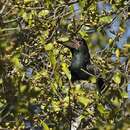en
names in breadcrumbs


Hornbills (Bucerotidae) are a family of about 55 large, charismatic bird species native to tropical and subtropical Africa, Asia, New Guinea, and nearby islands. They are most closely related to the hoopoes and woodhoopoes (Hackett et al. 2008). The name "hornbill" refers to the shape of the bill, which is long and down-curved like a cow's horn. The bill frequently bears bright colors and has ridges or notches on the side. Some species have a large casque, or helmet-like structure, on the upper bill. The first two neck vertebrae, the axis and the atlas, are fused. This condition is unique in birds and may provide more stable support for the large bill (Campbell and Lack 1985).
Despite the superficial resemblance, hornbills are not related to toucans although many are similar ecologically. Asian hornbills are primarily frugivorous and are important seed dispersers, while African hornbills are more carnivorous (Viseshakul et al. 2011). Hornbills breed monogamously, sometimes with helpers, and nest in natural cavities in trees or cliffs. All hornbills except for those in the genus Bucorvus seal their nest holes. Females do the final sealing, which likely protects her and the chicks from predators (Campbell and Lack 1985). Several hornbill species are vulnerable or endangered due to deforestation and/or small ranges on islands (IUCN Redlist).